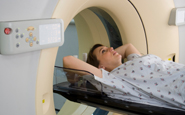 I CAUGHT THE DIRTY LITTLE SECRET
I CAUGHT THE DIRTY LITTLE SECRET
As a 44-year-old neonatal intensive care nurse at one of the largest medical centers on the west coast, the last thing I expected my doctor to tell me was that I had cancer. Not just cancer, but lung cancer, and it had spread throughout my body. In a flash, I saw my 4-year-old son, Jake, and fireman husband slipping away from me. Although cancer isn’t my specialty, I knew enough to realize that metastatic lung cancer was a death sentence. What followed was a series of grueling meetings, each doctor’s opinion more gloomy than the last. I was going to die.
What most people, particularly young people, don’t realize is that lung cancer kills more women than breast, ovary and colon cancers combined. Lung cancer is that dirty little secret that no one ever talks about. Why me? I didn’t smoke, didn’t have a family history of cancer, wasn’t exposed to any toxins and lived a healthy, active life. How could I have lung cancer?
A LUCKY NURSE
Luck would have it that the medical center where I work had just embarked on a new clinical trial under the guidance of Dr. Robert Nagourney, medical director of the Todd Cancer Institute in Long Beach, Calif. Dr. Nagourney, a published author, is a pioneer in a new field of cancer medicine called assay-directed therapy. Analyzing my cancer cells in the laboratory, Dr. Nagourney would identify which drugs would most effectively kill my cancer, as opposed to the cookie-cutter approach used at most centers.
In order to complete the analysis, Dr. Nagourney needed living cancer cells. The bad news/good news was that I had plenty of cancer to biopsy. A large cluster of lymph nodes jutted up from the space above my clavicle. With the assistance of a skilled surgeon, I was on my way to assay-directed therapy.
On the seventh day after my biopsy, Dr. Nagourney called me and said, with some enthusiasm, that he had found just the right treatment. The problem was that the drug he recommended, a pill called Tarceva, wasn’t used as first line therapy for my diagnosis. Instead, the FDA had approved it for patients after they failed conventional chemotherapy. Dr. Nagourney summoned me and my husband to his laboratory and actually showed me under the microscope how the drug Tarceva killed the most cancer cells in the test tube. I signed up for the clinical trial on the spot and started taking one Tarceva pill daily. Within weeks, the lymph nodes in my neck disappeared. A few weeks later, the blood tests that Dr. Nagourney was following returned to normal. And a few weeks after that, my PET scan showed significant improvement. I was getting better on a pill a day and the only side effect was acne.
CAUTIOUS DAYS
At first everyone was pleased, but cautioned me that this couldn’t last. After one year, people began to take notice, and by the second year everybody took notice. After all, the best standard therapy available, a toxic chemotherapy combination, provided an average survival of twelve months. Within months of starting treatment, my life returned to normal. My husband and I returned to Northern California where we own a walnut farm and harvested that year’s crop. We took our son, Jake, to Hawaii for a vacation, and I joined my husband at the Fireman’s Annual Retreat in Lake Tahoe. Had it not been for an injury sustained on the ski slopes, I would have come through my cancer treatment virtually unscathed.
Many people have heard the term “targeted therapy.” That is precisely what I was receiving. The drug Tarceva targets a protein found in cancers. In fact, scientists in the U.S. and Japan had just discovered a gene test that matches patients like me to this form of therapy, and Dr. Nagourney sent my tissue for the gene test. The problem is, my genes didn’t match the drug. Had I used the conventional wisdom, based on these gene analyses, I would not be writing this story today. As Dr. Nagourney points out in his lectures, there is a lot more to human biology than DNA, and I am a living example of that.
THE ONLY WAY TO CURE CANCER
Many scientists have tried to use tests like Dr. Nagourney’s, and failed. While there are many reasons why these doctors encountered difficulties, the tests that Dr. Nagourney developed represent an entirely new generation of analyses based on a new concept known as apoptosis, or programmed cell death. You see, my cancer cells weren’t growing faster than the normal cells in my lung—they just weren’t dying. And year after year, I accumulated abnormal cells until they showed up on my x-ray and in my lymph nodes. The drugs that worked on my cancer didn’t stop them from growing—they killed them outright. And that is the only way to cure a cancer.
Now, more than two years into my treatment, Dr. Nagourney has a collection of similar patients, as he reported in a study submitted to the American Society of Clinical Oncology. In Dr. Nagourney’s trial, the patients selected based on their activity in the laboratory are tracking a 100 percent response rate. When compared with the dismal 5 percent response rate in a clinical trial where untreated lung cancer patients received Tarceva first line, I’m certainly glad to have the benefit of personalized assay-directed chemotherapy.
NOTHING LASTS FOREVER
Nothing lasts forever, and after two years of great response, one of my blood tests showed a change for the worse. A PET scan was ordered and a few small areas of cancer were detected in the lung. While most oncologists might have called it quits, Dr. Nagourney arranged a biopsy of one of the areas of disease. With the new profile of drug sensitivity, Dr. Nagourney selected a completely different two-drug therapy that worked best for these new areas of cancer. After starting treatment a few months ago, Dr. Nagourney conducted follow-up studies confirming that the blood abnormalities were now undetectable and my PET scan was completely normal.
To cancer patients everywhere, I say, “No one is more interested in saving your life than you.” Every cancer patient is unique, and her treatment must be, too. If you know any cancer patients, regardless of what stage of treatment they’re in, they need to have the best treatment for them, not a “one size fits all” therapy. Take charge of your treatment and you can outlive your cancer, too.

















